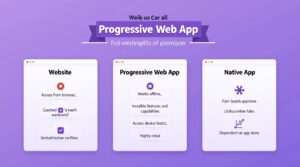click to get service View profile
Explore the best tools and strategies to enhance user experience with AI for UI/UX Design. Discover how AI-powered automation, research, and personalization can streamline design workflows and create smarter interfaces.
AI for UI/UX Design is revolutionizing the industry by enhancing creativity and efficiency. AI enables designers to automate repetitive tasks, generate intelligent design recommendations, and leverage AI-powered analytics for data-driven insights. With AI, designers can create multiple prototypes within hours and even conduct rapid testing to optimize user experiences. By integrating AI for UI/UX Design, professionals can streamline workflows, make informed design decisions, and enhance overall usability, making the design process more intuitive and effective.
In 2024, many companies are developing their own generative AI or integrating AI into their business operations. Over 80% of companies say that they are using AI for business strategies.
Mastering the optimization of generative AI is essential for enhancing AI for UI/UX Design. AI enables designers to improve personalization and gain deeper insights into user interactions. While there are numerous ways to leverage AI, its growing adoption presents challenges in maintaining design balance, depth, and meaningful insights. One of the biggest concerns is preserving the human touch that defines AI for UI/UX Design, ensuring that AI-driven solutions enhance rather than replace human creativity and intuition.
✔️ What AI Will replace
- Repetitive tasks: AI will handle simple tasks like pixel calculation and distances between components
- Manual work: Tasks like background removal, color change of components, cropping assets & filling in the background, and turning wireframes into initial Ui designs will be automated. Tools like Adobe Generative Fill & Uizard have been pioneers in this space.
- Tasks requiring repetitive thinking: AI will take charge of automatic context-aware translation, ensuring consistency, and responsive design testing.
❌ What AI Won’t replace
- Empathy: AI can’t grasp the emotion—how the other person feels or reacts. Though AI can have a conversation with humans, empathy, compassion, or any other emotion won’t be possible with current capacity. Humans interact with everything with emotion, & emotions will play a major role when designing anything.
- Combining & using multidisciplinary knowledge: Designing any product requires putting together knowledge from psychology, UX theory, content architecture, sometimes sociology, and wide data set research. AI can provide us with the information, but it lacks the system of thinking or preferences required to carefully put these together into a meaningful order.
- Qualitative user research: AI can provide us with information. However, it is hard to understand how users feel when they interact with it. AI can provide us with insights into multiple data points and more, but it cannot see the whole picture as a human designer is capable of. Connecting all the dots across various outputs is possible through human intervention.
How will AI shape design careers?
AI is reshaping the designer’s career in many ways. Let’s see how AI is transforming designers’ roles.
- AI is making designers more productive by increasing our efficiency. It will replace mundane tasks and allow AI UX designers to focus on the most impactful aspects of the work. This will help the designer improve their productivity and support them in finding more meaning in their work.
- AI can transcend designer skills and help them to grow naturally. With the help of AI, designers can achieve their ideal selves.
- By integrating AI into their daily lives, designers can scale and improve their research, iteration, and prototyping capabilities.
- As AI can come up with multiple design drafts, it will challenge the human aspect of design-knowing. It will propel designers to think outside the box to create a new design. In other words, it is empowering designers to work on creative aspects.
- It will allow designers to focus more on the user value by giving more time to optimize for important goals instead of menial details and repetitive tasks.
The Role of AI in User Research

Before any product development, user research is paramount, but it is a time-consuming and rigorous process a designer has to go through. But thanks to AI, user research has become much easier than before. It can process data quickly and provide valuable insights in a few minutes.
With the power of AI for UI/UX Design, conducting market research becomes more efficient and insightful. AI enables designers to collect key data on consumer needs, trends, and behaviors, helping them make informed design decisions. It also assists researchers in identifying common challenges, uncovering market gaps, and refining target audiences. By leveraging AI for UI/UX Design, professionals can access precise insights and actionable data, ensuring the creation of user-centric designs that drive engagement and enhance user experiences.
Regarding data processing and synthesis, it allows researchers to analyze large data sets, identify trends, and extract meaningful insights from interviews. It assists in visualizing data and uncovering key information and can also support research synthesis by extracting complex data into shareable formats.
In testing, AI for UI/UX Design plays a crucial role by predicting user behavior, generating heat maps, and conducting in-depth analyses. These AI-driven insights help researchers assess design effectiveness and pinpoint areas for improvement. By leveraging AI for UI/UX Design, designers can make data-driven decisions, optimize user interactions, and create more seamless and engaging user experiences.
In conclusion, AI should be viewed as a powerful ally that complements the fundamental human aspects of research.
AI for Data Collection and analysis
AI for UI/UX Design enables rapid analysis of large data sets, making raw information more understandable through machine learning algorithms. These algorithms categorize data, helping designers gain deep insights into user behavior, preferences, and pain points. With this knowledge, designers can create more personalized and responsive experiences. By integrating AI for UI/UX Design, professionals can bridge the gap between data-driven insights and user-centric design, ensuring a seamless and intuitive user experience.
Predicting User Behavior
Using AI for UI/UX Design, designers can leverage historical data and real-time analysis to predict user behavior accurately. AI-driven insights help suggest new features or improvements tailored to users’ needs, enhancing personalization and engagement. Platforms like Instagram and YouTube utilize AI algorithms to analyze user interactions and deliver personalized content accordingly. This approach leads to the development of intelligent user interfaces that are more intuitive, responsive, and capable of driving higher user engagement, ultimately improving the overall user experience.
AI-powered Design Tools

There are numerous AI tools available for designers, but selecting the right one can significantly streamline workflows. AI for UI/UX Design acts as a copilot, assisting designers by automating repetitive tasks, enhancing creativity, and enabling data-driven decision-making in just a few clicks. By automating tedious processes like layout generation, background removal, and content creation, designers can focus on core tasks, improving overall efficiency. Additionally, AI for UI/UX Design generates multiple design iterations, transforms text inputs into images and web interfaces, and suggests color palettes and typography that align with current trends, ultimately elevating the design quality and user experience.
Optimize Design Prototype and Testing
One of the significant impacts of AI for UI/UX Design is its ability to enhance the testing and optimization of design prototypes. AI enables designers to efficiently create, test, and refine multiple prototypes, allowing them to finalize the most effective version based on data-driven insights. Additionally, various AI-powered tools assist in auto-generating wireframes and suggesting templates, streamlining the design process and improving overall workflow efficiency.
By simply analyzing real-time user interactions with applications and employing dynamic prototyping, AI provides feedback that enhances designs, ensuring they are ready for practical use and better aligned with user needs. AI optimizes this process by delivering advanced simulations of user interactions, resulting in prototypes that more accurately represent real-world user behaviors and preferences.
Voice User Interfaces (VUI)
Voice user interfaces (VUI) enable users to interact with devices using natural language or spoken commands, eliminating the need for tapping or typing. By leveraging machine learning (ML) algorithms, VUI can accurately interpret language and deliver relevant responses. AI for UI/UX Design enhances this interaction by integrating conversational AI, which improves user engagement and reduces the cognitive load of traditional graphical interfaces. When effectively implemented, VUI allows designers to create seamless, natural conversations that enhance user understanding and accessibility. By analyzing historical data, AI-driven VUI continuously refines its responses, providing a more intuitive and efficient user experience.
Harnessing AI feedback to elevate UX design with Human Creativity
Utilize AI Feedback to Refine the Design
Effective feedback plays a crucial role in enhancing design and user experience. By leveraging AI for UI/UX Design, designers can test new prototypes, analyze performance, and identify areas for improvement. AI-driven feedback systems provide valuable insights, allowing designers to refine their designs efficiently. Iterating based on AI-generated suggestions helps streamline the process, reducing the time required to finalize a product compared to traditional methods. Additionally, AI enables designers to test multiple design ideas simultaneously, ensuring a more data-driven and user-centric approach to UI/UX development.
Balancing AI and Creativity
Relying on AI-generated feedback can help designers create effective designs, but it may lead to monotonous results that lack originality. To make designs truly stand out, it’s essential to use AI for UI/UX Design as a tool rather than a final decision-maker. Designers should not blindly follow AI-generated data; instead, they should blend AI insights with human creativity to craft user-centric and engaging designs. The key is to strike a balance—leveraging AI-driven recommendations while infusing originality, intuition, and emotional depth into the design process. This approach ensures that designs remain innovative, visually appealing, and highly functional.
Streamline team efficiency and productivity.
A growing number of design teams are leveraging AI for UI/UX Design to automate repetitive tasks, boosting productivity and efficiency. By integrating AI into the workflow, designers can streamline processes, automate small yet time-consuming tasks, and free up time to focus on enhancing user experience. AI for UI/UX Design accelerates the design process while improving overall quality, enabling teams to deliver polished, user-friendly, and innovative designs. However, while AI can handle data-driven tasks and automation, human creativity and intuition remain essential for crafting unique, engaging, and emotionally resonant user experiences. The key is to balance AI’s capabilities with human-driven design thinking.
But while AI can take care of the grunt work, human creativity and intuition are still crucial for making designs stand out.
These days, using AI isn’t optional—it’s a must if you want to improve efficiency and get more done.
Final Thoughts
To put it into perspective, AI for UI/UX Design is revolutionizing the design process. From automating tasks to streamlining workflows and accelerating prototyping, AI enhances every stage of UI/UX design. It acts as a powerful assistant, enabling designers to work more efficiently and boost productivity. By leveraging AI for UI/UX Design, professionals can optimize their creative process, reduce manual effort, and focus on crafting user-centric experiences. Embracing AI is essential for designers who want to stay ahead in the ever-evolving digital landscape.
If you are looking to improve your brand’s UX design, look no further. Lollypop provides a best-in-industry design that resonates with users and increases user engagement.
FAQs
- How is AI used in UI/UX design?
AI is used to automate repetitive tasks, analyze user data, create prototypes, and optimize designs to enhance user experiences and efficiency. - Will AI replace UI/UX designers?
No, AI complements designers by handling mundane tasks, while creativity, empathy, and human-centered design remain irreplaceable. - What are the benefits of AI-powered tools for designers?
AI tools improve productivity, streamline workflows, provide data-driven insights, and support rapid prototyping and testing. - Can AI personalize user experiences?
Yes, AI analyzes user behavior and preferences, enabling designers to create highly personalized and responsive interfaces. - What challenges do designers face with AI in UI/UX?
Balancing AI-driven efficiency with maintaining creativity, empathy, and the human touch in design is a key challenge.

